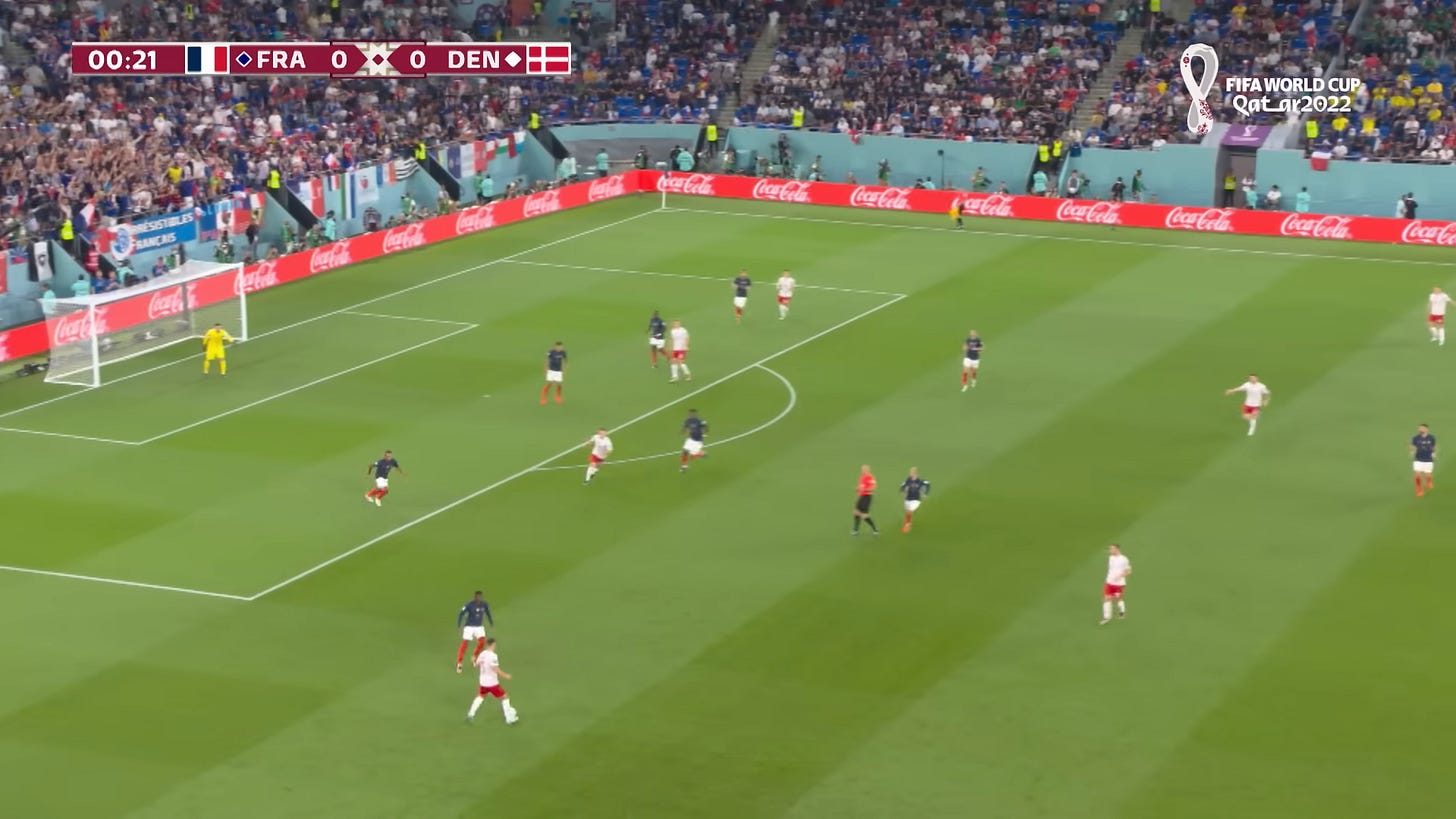Behind France's World Cup 2022 campaign.
Deschamps' Les Bleus have reached a World Cup Final for the second time in a row, displaying superb individual quality and a fairly flelxible system.
In the run-up to the World Cup, I’d predicted that France would underperform due to their form in the Nations League, the number of injuries, and the superstition that World Cup winners struggled in the next tournament.
Didier Deschamps, on the other hand, has implemented a system that has managed to carry forward his principles while maximising his players' talents. France's style of play, individual performances, and games have all impressed me in their own way, prompting me to write a piece about their tactics and players.
The System
Didier Deschamps employs a 4-2-3-1 formation that changes depending on game state and possession. Poor on the ball, Hugo Lloris remains a reliable shot-stopper, and Varane and Upamecano possess strong defending fundamentals(although the latter can be error-prone at times). The injury of Lucas Hernandez has led to the introduction of Theo Hernandez into the XI, whose inclusion has allowed France to hold width and create more. If he holds width, Mbappé can make runs into the box, and if he drifts inside, Mbappé can use his elite 1v1 ability to disrupt defences.
The midfield has changed dramatically, with Adrien Rabiot and Aurélien Tchouaméni excelling at covering the base. France's attack has been stronger than ever, despite Benzema's absence. Mbappé is on fire, scoring five goals and assisting twice while playing off the selfless Giroud, who is now France's all-time leading scorer. Dembelé's 1v1 threat and chance creation have added another dimension to the attack, making it even more lethal.
Griezmann: The glue
With talks of him slowing down, Antoine Griezmann’s resurgence has been key to this France side. Arguably Player of the Tournament, Griezmann has been an excellent interpreter of space, linking up and creating combination plays to a devastating effect. He’s also got an eye for a pass, creating the most chances in the World Cup. His work rate has been put to great use as he’s also been integral in providing defensive solidity, averaging 3.3 tackles+ interceptions a game. His awareness of making the right decisions, and occupying the right spaces, is what keeps this France side together.
Attacking principles
France's formations vary from 2-4-4 to 2-3-5. Varane and Upamecano remain at the back to aid in the build-up (though the latter isn't as skilled on the ball). Hernandez and Koundé push forward, providing width. Hernandez or Rabiot move into the left half-space. If they overlap, Mbappé can cut in and run behind defences, and if they underlap, Mbappé's 1v1 abilities are put to good use. Griezmann drifts into the right-half space, essentially as a right-sided midfielder, combining with Dembelé and Giroud. The latter's hold-up play is excellent, and it benefits Griezmann, who thrives in space.

France, however, are not a possession-heavy team. France prefer to hit teams on the counter, where Griezmann and Dembelé can cut through defences to find Giroud and Mbappé, whose lightning pace and dynamism fit this style of play perfectly.
Speaking of Mbappé, his completeness as an attacker cannot be understated. He is a phenomenal athlete with incredible dribbling, off-the-ball movement, and ball-striking, whilst also showing pausa in his game- the ability where one draws in defenders, and waits before a perfect opportunity presents itself to pass to a teammate.
Defensive Approach
Out of possession, France’s shape can vary from a 4-2-3-1 to a 4-4-2. When teams attack France, they press very little, set up in a mid-block, and prefer to sit deeper. Rabiot and Tchouaméni are a hardworking duo who constantly scan the field for danger and potential threats. Rabiot's form has been a surprise, as he enjoys going forward to contribute to the attack as well as helping out at the back. As previously stated, Griezmann's defensive play has been a boon. When defending, he sits in a pivot position and even goes deeper into the defensive third to help pick up the ball in the first phase.
Right before the tournament, I’d criticised Deschamps before the tournament for his inability to evolve to a more attacking approach, but there is always more than one way to play the game. As bad as the press is, and as deep as they sit against attacks, the attacking quality in the final third is a massive boost, and the system has clear tactical flexibility if things go wrong. For example, if France need a late goal, Deschamps subs on Marcus Thuram, who is a useful outlet on the left, with Mbappé playing as a number 9. This was a key substitution that also led to France’s second goal vs Morocco.
Possible weaknesses?
Mbappé is a phenomenal talent, but if there's one thing he can improve on, it's his defensive commitment. Mbappé's failure to track back or defend diligently leaves Hernandez and Rabiot with too much space to cover, allowing opposition wingers and fullbacks to easily exploit that side.
Whatever happens on Sunday, France have proven to be a well-balanced team. Deschamps has done a fantastic job of managing the balance, and has demonstrated a great understanding of player profiles.








